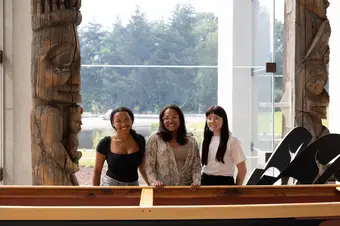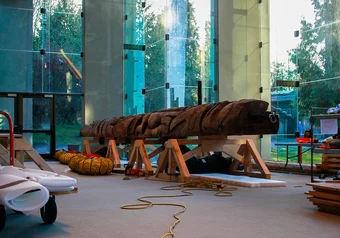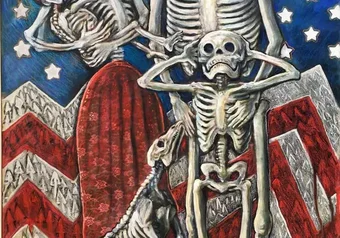The Native Youth Program (NYP) was a part of Amai Campbell-Kamangirira’s life long before she applied to join. Her grandmother and aunt, both Musqueam, spoke of it frequently and positively — they had each enrolled in the program at age 15. In 2021, they encouraged her to do the same.
“They were like, ‘Oh, you should do it, you should do it!’ And then I did it and I was obsessed with the program,” Campbell-Kamangirira said. “They haven’t gotten rid of me yet.”
The NYP, a summer work-learn program for Indigenous secondary students offered by the Museum of Anthropology (MOA), is the longest-running Indigenous youth program in the country. In 1978, MOA curator Madeline Rowan and Heiltsuk educator Brenda Taylor conceived of the program as a unique opportunity for Indigenous high school students to get involved with museum and curatorial work. They applied for federal funding and hired on the NYP’s first cohort of students in the summer of 1979.
Rowan and Taylor led the program for its first 15 years before handing directorship to MOA Curator of the Pacific Northwest Pam Brown in 1994. After Brown’s retirement in 2020, the MOA invited Squamish curator and educator Damara Jacobs-Petersen to take her place.
“[Pam Brown] called and was like, ‘Hey, I know it’s crazy; there’s a global pandemic and the world’s insane, but there’s a couple people here who still remember you,’” said Jacobs-Petersen.
Originally from the North Shore, Jacobs-Petersen had worked as an intern at the MOA in the early 2000s, but left after a few years when it became clear a long-term place at the museum wasn’t in the cards.
“I saw that there was never going to be a permanent full-time position for me here as an Indigenous curator and educator, because the museum just wasn't set up like that at the time,” she said.
After curatorial stints at various United States institutions — the National Museum of the American Indian, the Tacoma Art Museum — she got the call from Brown in 2020 and agreed that it was time to come home.
This year, Jacobs-Petersen works in close collaboration with NYP Manager Jacqueline Morrisseau-Addison and Campbell-Kamangirira who, after three seasons of NYP participation since being nudged towards the program by her relatives, now works at the MOA as a cultural interpreter.
The three of them were hard at work, preparing for the incoming NYP cohort, when The Ubyssey spoke with them in the MOA’s open-concept offices. Colleagues and curators shuffled busily, occasionally jumping in to ask Jacobs-Petersen about an email or what she’d wanted them to do with that Māori hook they’d spoken about.
Planning for a given cohort’s NYP experience can be a daunting task. The programming changes from year to year — Morrisseau-Addison’s managerial role is a year-long position that has an extensive impact on the specifics of the NYP’s offerings, so different yearly managers can lead to vastly different programs.
“The core components [of the NYP] are always tour guiding, a podcast project and art-making,” said Jacobs-Petersen.
A focus on Indigenous craft and construction has been at the core of the NYP since 1979 — the first cohort’s curriculum focused mainly on the use of cedar trees in Coast Salish society — but in recent years, Jacobs-Petersen has placed an emphasis on individual artistic expression. Encouraging students to find creative ways of exploring and expressing their individual Indigenous identities, she said, is an integral part of the program.
“We've made drums and woven baskets, but we've also done experimental photography and film and done all this other cool stuff.”
The NYP’s podcast project, a flagship part of its programming since 2015, began as a collaborative initiative with campus radio station CiTR. Students visited the station for lessons on podcast production, with CiTR alum and music journalist Nardwuar giving motivational speeches and interview pointers. For the past three years, the podcast project has been produced in-house at the MOA, with CiTR airing the final product.
Like the NYP as a whole, the character of the podcast project changes each year. The 2021 cohort explored the theme of origin stories — students wrote histories of their nations, conducted interviews with their peers and composed original songs and interludes. The following year, students explored their experiences at school and how they intersected with their Indigenous identities.
Tour guide training and practice has been at the core of the NYP since its first cohort wrote and presented lessons to museum-goers on Indigenous cedar use. That focus continues today, with NYP students having the opportunity to plan and execute personalized tours and present with curators on other exhibits, like 2022's Xicanx: Dreamers + Changemakers.
Last November, Jacobs-Petersen created the cultural interpreter position to expand the MOA’s collaboration with NYP alumni and give graduates the chance to continue their work in museum tour-guiding.
The cultural interpreter initiative, said Jacobs-Petersen, is “inviting alumni back into the museum to provide tours that they've written themselves that are focused solely on objects from their communities of origin and other belongings that speak to them.”
Campbell-Kamangirira and two of her fellow NYP grads represent the pilot cohort of this program.
“[The] NYP definitely trained me to do this,” she said. “It grew my confidence, and I was able to learn how to start writing better, how to properly give a tour [while] being able to be myself, but also acting professional.”
Many of Campbell-Kamangirira’s fellow NYP graduates share her enthusiasm for the program, but some have expressed criticism, particularly of its overly historic lens and its often-precarious funding status. In her 2012 book Indigenous Teenage Interpreters in Museums and Public Education, NYP founder Madeline Rowan records testimonials from several people who had participated in the program as students or managers.
“A lot of the program is concerned with history but a lot more current issues should be included,” NYP graduate Eileen Joe is recorded as saying. “Some economics perhaps would be a good idea, more on economic development, land claims, and treaties information.”
Also recorded in Rowan’s book, former NYP Manager and Executive Director of the Union of B.C. Indian Chiefs Don Bain reflected on the insufficiency of academic programs like the NYP in reproducing and strengthening aspects of Indigenous culture in the younger generation. Community and familial networks, he argued in Rowan's book, must remain at the heart of Indigenous pedagogy.
“First Nations cultural workers in schools aren’t there to define cultural identity of students … just the way you couldn’t define European culture by talking about different European countries in a classroom; the onus is on the parents to instill spirituality and identity in their children."
Bain was also concerned about the NYP’s lack of stable funding.
“The program does need support, stability. It can’t float from year to year … money is a problem.”
Although these testimonials were recorded nearly a decade before Jacobs-Petersen became director, financial concerns, she said, are still a major limitation on the NYP’s scope.
“[Funding is a] massive strain. It’s really brutal and heartbreaking that we have to pick and choose what’s most feasible, what we can handle with our limited capacity and budgetary constraints.”
It was only due to an increase in this budget that Jacobs-Petersen was able to launch the cultural interpreters position last year. She has more plans for expansion, she said — a formal network for NYP graduates to connect and return as educators and role-models, as well as an increased curricular focus on connections with Indigenous peoples across the globe — but these efforts cost money, for which the NYP relies on external grants.
Mementos of cohorts past adorn Jacobs-Petersen’s office space. Paintings and poems by NYP alums hang from walls and cork boards; a small stingray and turtle fashioned from fishing nets reclaimed from the Torres Strait stand on her desk. Some of these little sculptures are now displayed as part of an Indigenous-led public art installation in Barangaroo, Australia. Despite monetary constraints, Jacobs-Petersen and the NYP remain focused on forging international connections and local understanding for new generations of Indigenous youth.
“This is global,” she said. “I want to see, what does that look like when I take something like this and formalize it into a larger initiative? … There’s going to be some beautiful synergy. I’ve got some plans.”
First online
Share this article







